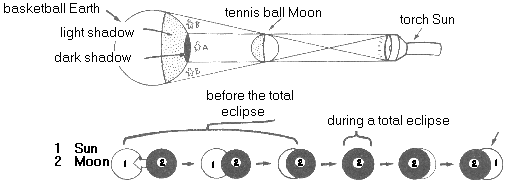
TIDES, ECLIPSES, DAY AND NIGHT, AND THE SEASONS
Graph Tide Tables
- Materials you need are:
- this year's tide tables for one month
- some graph paper
- a ruler
- a pen
Note that tide tables show the time in 24-hour time (e.g. 2.30am= 0230, 9am=0900, 12.45pm=1245, 6.40pm=1840 and so on) and the height of the low or high tide each day. There are 2 high tides and 2 low tides on most days. When you graph the tides, make the horizontal axis the times through the day and the vertical axis the tide heights.
Observing a Solar Eclipse
- Safety rules:
- Parent supervision (you should not look directly at the sun!)
- Materials you need are:
- patience (The sun doesn't have an eclipse every day!)
- the sun!
- a sheet of cardboard with a pin hole in the centre
- a sheet of smooth paper
- measuring tape
Stand with you back to the sun. Hold the cardboard so that light from the sun shines through the hole in the cardboard onto the paper. Hold the sheets about 1 metre apart.
You should see an image about 4 cm across.
Model a Solar Eclipse
- Materials you need are:
- a torch with the same diameter as a tennis ball
- a tennis ball
- a basketball
Line up a basketball (Earth), a tennis ball (Moon) and the torch (Sun) as in the diagram below. If you were on the earth in Position B in full shadow, you would see a Total Solar Eclipse, that is, nothing of the sun except the outer glow. If you were on the earth in Position A or C in partial shadow, you would see a Partial Solar Eclipse.
